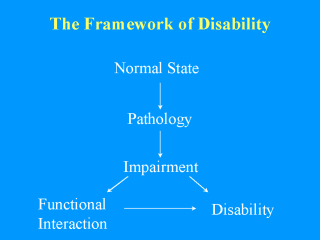 |
Disability is a
multidimensional state of health. Disability can be defined quite narrowly or quite
broadly. There is currently no standard definition used in the literature. Very early on,
disability was defined solely by the presence of a physical disability, such as the loss
of a limb. The work of two individuals, Saad Nagi and Philip Wood, though, moved the
discussion beyond physical disabilities and into a broader domain. Both individuals
described disability in terms of its impact on the individual (physical, medical,
anatomical, and emotional), and its impact on lifestyles. These are, in turn, mediated by
the environment and family situation in which the person lives. In the late 1960s and
early 1970s, Nagi outlined disability in terms of four closely related views: pathology,
impairment, functional limitation, and disability. The relationship among these views is
shown here. Active pathology represents interference in the normal processes of the
organism, such as the onset of disease. This pathology may lead to an impairment (an
anatomical, physiological, mental, or emotional loss or abnormality). Impairments, though,
may arise independent of a pathology. Impairments may then exert their effects in terms of
functional limitations (a limitation in functioning or performance at the individual
level, e.g., a problem in seeing, hearing, walking, or reaching), or in terms of
disability (a limitation in performing socially defined roles, e.g., self-care or work). |
